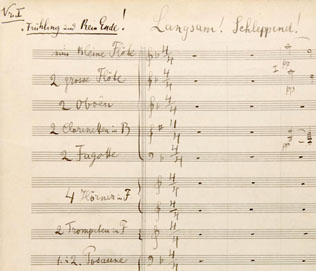Both Mahler’s First and Second Symphonies raise the question of whether Mahler intended his music to have particular extra-musical meanings. Throughout his life, Mahler struggled with whether and how to explain his music to the public. He originally named his First Symphony the Titan, and gave the movements the following titles:
—Spring without end
—A chapter of flowers
—With full sails
—Stranded! A funeral march in the manner of Callot
—From hell to heaven, as the sudden expression of a deeply wounded heart.
By the time of the music’s publication in 1898, he had withdrawn the second movement as well as these titles. Yet he returned to explanation in the Second Symphony, expounding his concept that the hero of the First Symphony is borne to his grave in the funeral music of the Second and that “the real, the climactic dénouement [of the First] comes only in the Second.”




